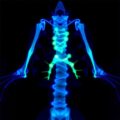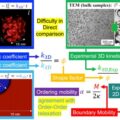
In recent research that unveils novel strategies for combating anthrax, University of Pittsburgh scientists have demonstrated a groundbreaking approach to treating the life-threatening disease. Known primarily as an infection induced by the bacterium Bacillus anthracis, anthrax poses significant dangers, particularly due to its potential as a bioweapon. While the disease can often be effectively managed if diagnosed in its nascent stages, the consequences become dire when patients reach what researchers term the “point of no return.” This threshold occurs alarmingly swiftly, often within just a few days after symptoms emerge, making timely diagnosis and treatment critical.
The findings, published in a notable study in Nature Microbiology, involve a creative cocktail of growth factors that showcase the potential to reverse cellular damage that lethal anthrax toxin inflicts in mouse models. This research introduces a new dimension to the realm of anthrax treatments, particularly for cases that progress beyond traditional medical interventions. Senior author Shihui Liu, M.D., Ph.D., an associate professor of medicine at the University of Pittsburgh School of Medicine, emphasizes the necessity of innovative treatment avenues for treating anthrax at more advanced stages of infection.
Conventional treatments for anthrax, such as antibiotics and neutralizing antibodies, are effective primarily at early disease stages when the bacterium can still be eradicated or toxins can be neutralized before they enter cells. Once the lethal toxin penetrates the target cells, however, it cleaves essential enzymes known as MEKs, leading to substantial cellular dysfunction. This disruption sets off a cascade of cellular signaling failures, ultimately triggering widespread damage across tissues and organs, culminating in patient mortality. The urgency to extend treatment efficacy beyond this critical point is underscored by Liu, who notes that the non-specific, flu-like symptoms of early-stage anthrax often delay diagnosis until interventions become futile.
In their pursuit to understand the mechanisms by which anthrax causes cell death, Liu’s research team developed genetically modified mice with MEKs that are resistant to damage inflicted by the lethal toxin. These altered MEKs—specifically MEK1/2 and MEK3/6—control vital signaling pathways that govern cellular survival and division. When exposed to either lethal toxin or the bacterium itself, these genetically altered mice displayed a marked increase in survival when compared to their unaltered counterparts. This discovery reveals that both pathways need to be inactivated by anthrax for the host to succumb to the infection, indicating a potential vulnerability that the researchers can target.
The breakthrough continued as Liu’s team identified a specific combination of three growth factors that appeared capable of rehabilitating the potentially fatal consequences caused by anthrax toxin. Each growth factor has previously undergone safety evaluations and received approval for use in treating other medical conditions. Remarkably, when administered to both mice and human cells that were exposed to anthrax toxin, these growth factors reactivated the ERK pathway, leading to cellular rescue and regeneration from the brink of collapse.
The implication of these findings is profound. The research team initially held a belief that the damage resulting from lethal toxin exposure was irreversible. However, the ability to reactivate critical signaling pathways like ERK represents a vital turning point in approaches to treat anthrax, particularly in acute phases where rapid cellular death typically occurs. This opens a pathway for further investigations into how to implement such treatments effectively in humans, emphasizing the versatile nature of growth factors in restoring cellular function and survival.
Ongoing efforts by Liu and his colleagues involve refining treatment protocols that consider the varied cellular requirements for different growth factors, indicating a tailored approach that may improve the efficacy of the proposed therapy for anthrax patients. Collaborative efforts with researchers from other institutions, including experts from China Medical University and the National Institute of Allergy and Infectious Diseases, reflect the inter-institutional commitment to advancing this promising research front.
These developments come at a time when vigilance against potential biological threats remains paramount. Despite the rarity of anthrax cases in the United States, the specter of its use as a bioweapon casts a long shadow over national security considerations. Liu’s groundbreaking work addresses an urgent gap in the capacity for effective treatments of post-exposure anthrax, ensuring that the research undertaken not only contributes to academic advancement but ultimately has real-world implications for public health and safety.
Furthermore, the study suggests that as scientists continue to explore the mechanisms of anthrax and refine their therapeutic strategies, breakthroughs like this may pave the way for new principles in managing not just anthrax but potentially a variety of infectious diseases characterized by similar pathways of cellular injury and death. This vigilance, innovation, and commitment to uncovering effective treatment methods are vital ingredients in the ongoing fight against infectious diseases that pose threats to human health.
Building upon this groundbreaking research may unlock new frontiers in drug development, with implications that extend far beyond anthrax treatment. A deeper understanding of how growth factors can restore cellular mechanisms after toxin exposure could serve as a scaffolding for advances in treating other diseases marked by similar biochemical insults. Researchers remain optimistic that as they unravel these complex interactions at the cellular level, they will find more efficient ways to stem the tide of infectious diseases that challenge medical science today.
In conclusion, the research led by Liu and his team exemplifies an exciting step forward in the treatment of anthrax, illuminating pathways to novel therapies that could transform our approach to combating not just anthrax, but other infectious diseases that cause significant mortality risks. As work continues to develop and optimize these interventions, the potential for saving lives becomes increasingly tangible, underscoring the crucial role of scientific inquiry in addressing public health challenges.
Subject of Research: Anthrax treatment and cellular recovery
Article Title: ERK pathway reactivation prevents anthrax toxin lethality in mice
News Publication Date: 28-Mar-2025
Web References: Nature Microbiology
References: Nature Microbiology, University of Pittsburgh
Image Credits: UPMC
Keywords: Anthrax, Bacillus anthracis, Growth factors, ERK pathway, p38 pathway, MEK proteins, Lethal toxin, Infectious disease, Bioweapon, Cellular signaling, Treatment strategies, Cellular recovery
Tags: advanced anthrax infection therapiesanthrax bioweapon risksBacillus anthracis infection managementcritical diagnosis and treatment of anthraxgrowth factors for cellular damage recoveryinnovative medical interventions for anthraxNature Microbiology study on anthraxnovel strategies for anthrax treatmentovercoming limitations of conventional anthrax treatmentspoint of no return in anthraxShihui Liu anthrax studyUniversity of Pittsburgh anthrax research







No Comments
Leave a comment Cancel